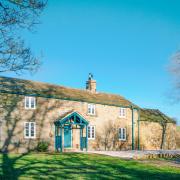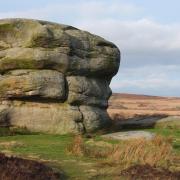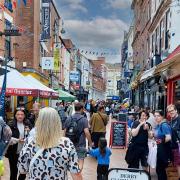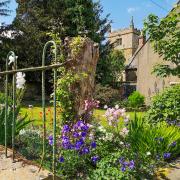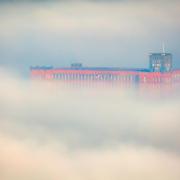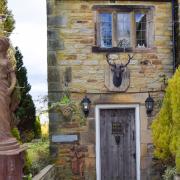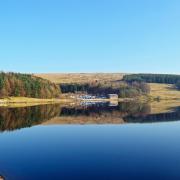Mike Smith heads to beautiful Tideswell to take in the magnificent 'Cathedral of the Peak'.
Due to its great size and magnificent architecture, the parish church of St John the Baptist in the village of Tideswell is known as the ‘Cathedral of the Peak’.
It is described in Randall Rawlins’ Survey of the Parish Churches and Chapels in the County of Derby as ‘without exception, the most perfect and beautiful specimen of pointed architecture to be found in the county - or perhaps in any other parish church of its size in the entire kingdom’.
The church is unusual in having been constructed entirely in the 14th century, without any significant alterations being made since that time.
According to the Britain Express website, ‘The relatively short building span means it is a remarkably complete example of the Gothic Style.’
The earliest parts of the structure, including the nave, were commenced in 1320 and are fashioned in the Decorated Gothic style.

The fine chancel, built after an interruption due to the devastating effects of the Black Death, is in the Perpendicular Gothic style, with tall, square-headed windows of clear glass allowing daylight to flood into the building, creating what has been called a ‘gallery of light and beauty’.
The distinctive tower was the final addition, completed in 1400. Its eight pinnacles create a wonderful silhouette when viewed from the shallow hills surrounding the village.
A TRUE RESTORATION
In common with many other parish churches, Tideswell Church was subject to a restoration in the Victorian era, but its medieval appearance was not corrupted in any way by inappropriate changes and additions, which happened in many other churches.
The renovation, carried out in 1873 by John Dando Sterling, was described by the Manchester Courier and Lancashire General Advertiser as ‘a genuine restoration rather than a reconstruction’.
The newspaper added, ‘it is a relief to see so fine a specimen of fourteenth-century architecture in trustworthy hands.’
Most visitors to Tideswell are taken by surprise when they see such a splendid church at the centre of a village largely composed of unpretentious stone buildings. There are two probable explanations for this unlikely presence.

In the 14th century, Tideswell was benefiting from a demand for lead extracted from the local rakes, and it was the home of several wealthy individuals, particularly Nicholas de Stafford, John Foljambe and Thurstan de Bower, who were able to contribute generous sums to the construction of a building that would reflect the village’s new importance.
The fine architecture of the nave and the chancel is complemented by impressive tombs, brasses and other furnishings.
One brass depicts Sir Sampson Meverell, who fought eleven battles against Joan of Arc, and a pair of tombs in the lady Chapel are effigies of ladies whose names are not known.
Not all the special features in the church are easily visible to the naked eye, particularly those hidden in the ceiling vaults.
However, thanks to high-resolution images taken by local professional photographer Bernard O’Sullivan, their details have been revealed.
They include a trap door inscribed with the names of the churchwardens of 1812, a mirror-written inscription on a shield, a pulley which may have supported a chandelier, and carvings of angels on the vaults of the chancel.

The Hunstone Carvings
Most noteworthy of the church’s furnishings are the ‘Hunstone carvings’.
These were begun in 1895, when Canon Andrew asked Advent Hunstone, a local stonemason, if he could turn his hand to woodcarving, in order to decorate the casing for a new organ and a screen that would divide it from the Lady Chapel.
Advent took up this challenge with great enthusiasm and began to show remarkable skill in producing woodcarvings of outstanding originality and variety.
Four generations of the Hunstone family have carried on this work to the present day. A remarkable dynasty!
The Hunstone carvings include some particularly moving images, such as those representing baptism, confirmation, ordination and visitation of the sick.
More unexpectedly, some of the carvings include images of a dragon, an elephant, a boar, a hippopotamus, a bear, a rhinoceros and a pelican feeding its chicks.
As Canon Hulbert observed, ‘They almost become a study in zoology.’
WHILST YOU ARE THERE
Tideswell is a large village with a good choice of pubs, cafés, restaurants and independent shops.
The church provides the wonderfully atmospheric setting for the annual carol service, whilst the surrounding countryside is perfect for winter walks and for visits to lots of picturesque villages.
The George
Standing adjacent to the church, the George, a former coaching inn with eight deep-set Venetian windows, completes a stunning set piece that would make a perfect illustration on a Christmas card.
The inn has accommodation and is the venue for a cinema showing digital screenings of top films.
Other Pubs with accommodation
The Merchants’ Yard offers accommodation in boutique rooms and has an AA award-winning restaurant. The Horse and Jockey is a traditional village pub with accommodation.
The Anchor
According to legend, a deserting sailor walked inland until he reached a point as far away from the sea as possible, where he put down his anchor.
This is the location for the Anchor, a well-known country inn dating from 1699, which has recently been refurbished.
Litton
Litton, located one mile from Tideswell, is a very picturesque English village, with a green, stocks, a cross, a village school, a popular pub and a well-stocked community-run shop and tea room.
Great Hucklow
Great Hucklow, two miles from Tideswell, is famous for its great display of Christmas lights, with brightly-illuminated Christmas trees being placed in front of every house in the village.
Tideswell Dale and Monsal Dale
A footpath alongside the river Wye runs below overhanging limestone cliffs that are much favoured by rock climbers.
It links Tideswell Dale with Monsal Dale, passing Litton Mill, Water-cum-Jolly Dale and Cressbrook Mill on its way to a celebrated viewpoint at Monsal Head..




